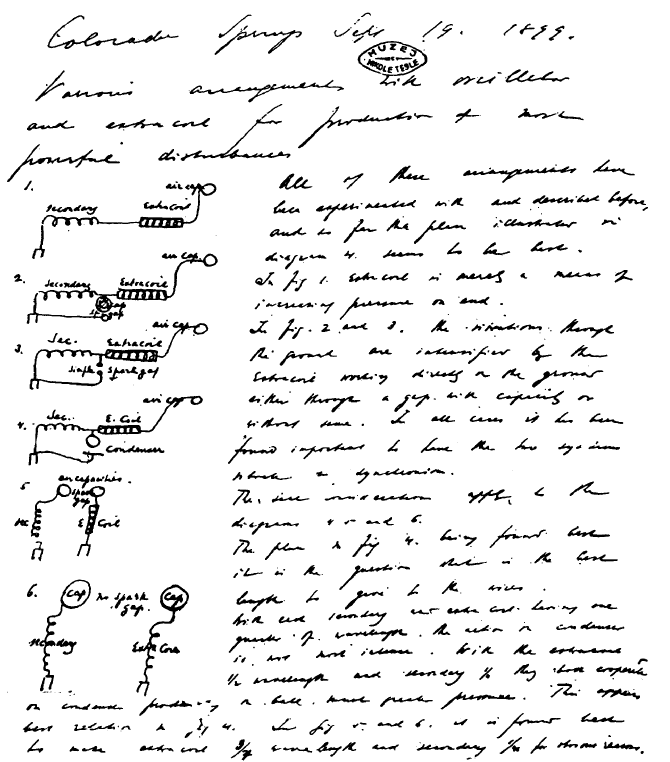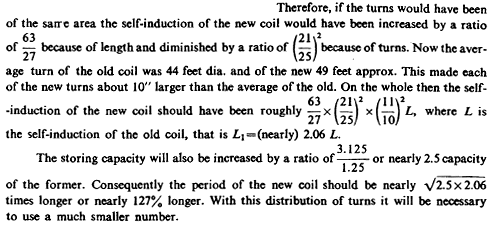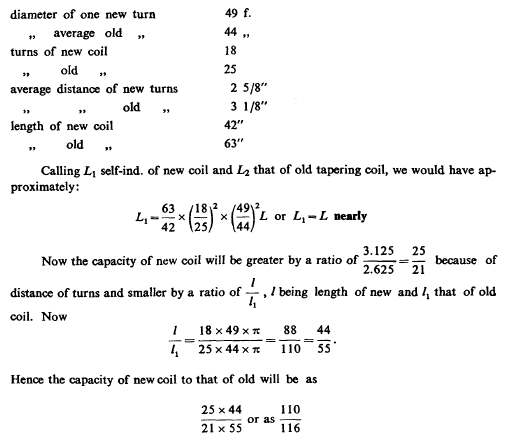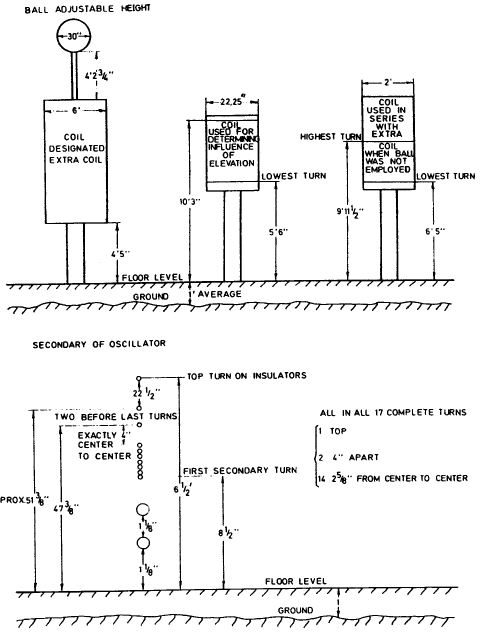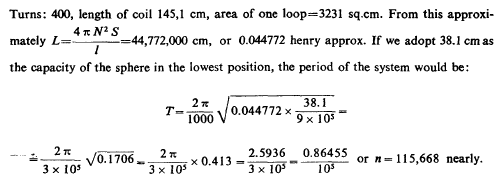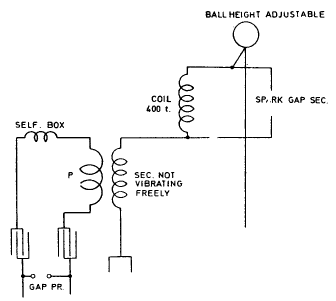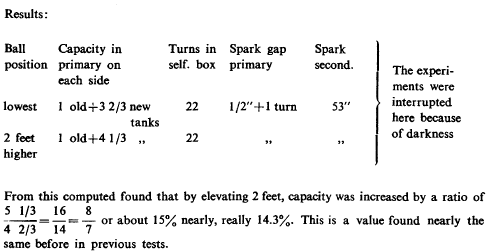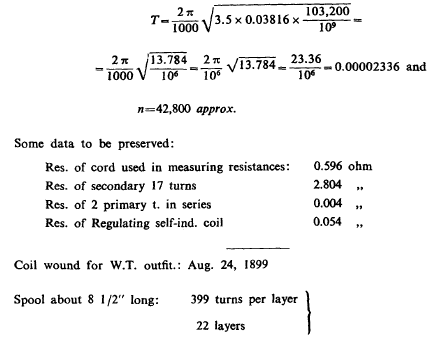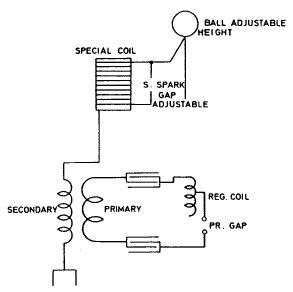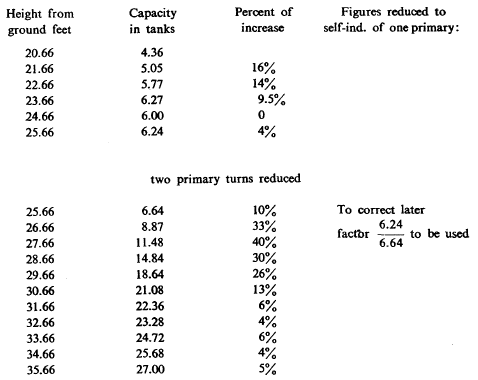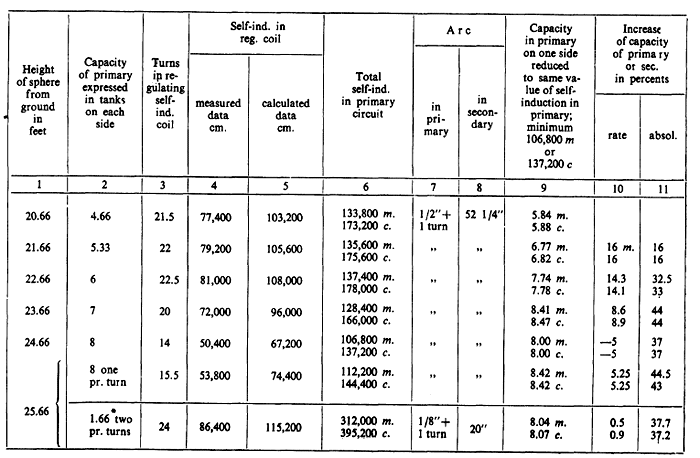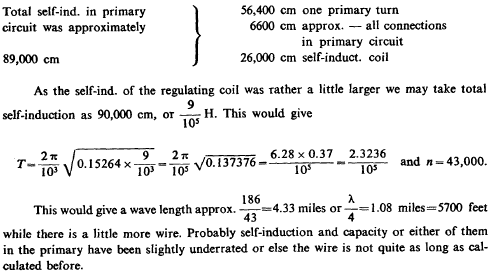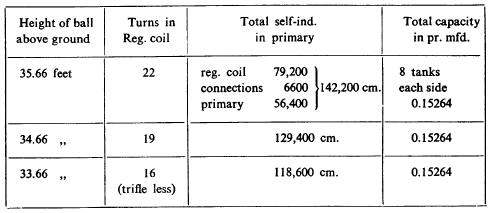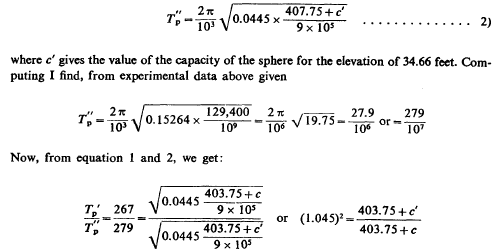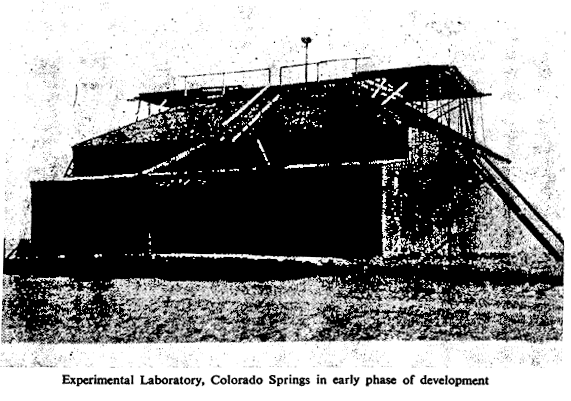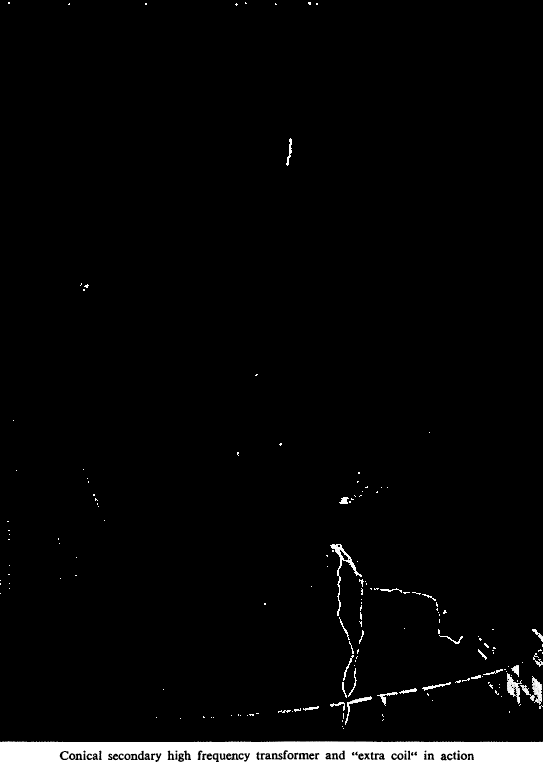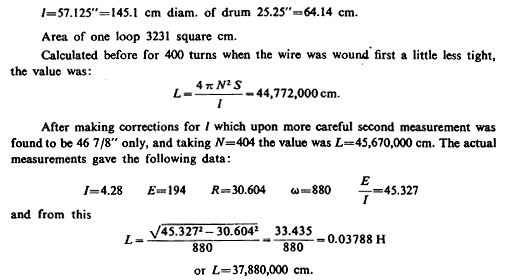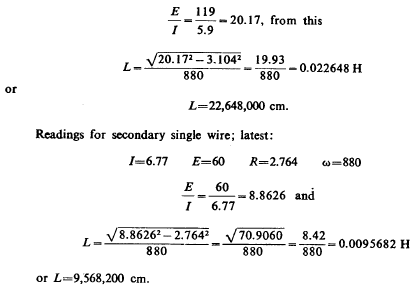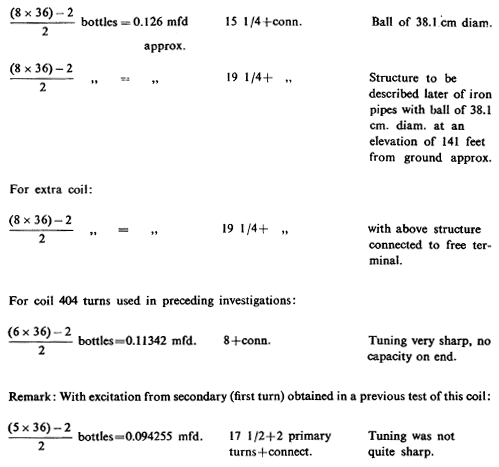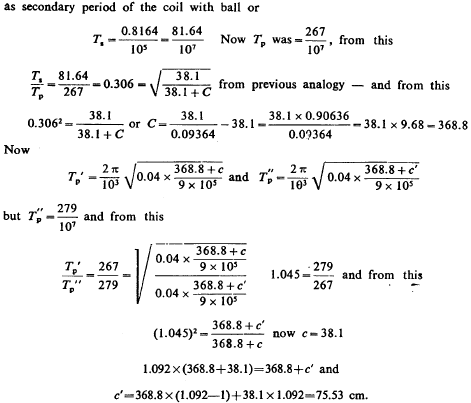|
Colorado Springs Notes
-
October 1-31, 1899
Colorado Springs
or very nearly equal.
Therefore the
distribution of the turns will secure nearly the same period of
vibration as in the old coil.
The utmost we could take would be 1/2 surface of
wire, that is 3000 π sq.cm. and this would be only 1/2 of surface of sphere. But other
things considered, it would appear that the error due to
electrostatic and distributed capacity of the coil itself would be
small. This is however to be further investigated and allowance made
for. It would be, of course, desiderable to entirely do away with
the capacity of the coil to make the results of the observations
rigorously true, but this will be hardly possible.
This is a vibration far too quick, in reality it will be much slower because of capacity in the coil. Diagram shown illustrates arrangement used in experiments: The coil of 400 t. was excited by secondary of oscilator, and capacity and self-induction in primary were varied until resonance of free system comprising coil of 400 t. and ball of 38.1 cm cap, was obtained. This was evident from spark length and other indications, as streamers.
Now a ball 38.1 cm. was added on the end and placed near the earth
plate at a distance of about 3 1 /2 feet but very little affecting
the vibration. This shows that distributed capacity in secondary is
very large as before.
Latest secondary in receiving
apparatus, No. 30 wire, 90 turns per layer, 35 layers Res. 424 ohms.
The roof was covered with some sort of tar paper the influence of which can only be conjectured at present. The most reliable data will be those obtained with ball at the highest points when it is above all structures.
The connections used are
shown in diagram. The ball was lifted by steps of one foot each and
the primary self-induction and capacity was adjusted until maximum
resonant rise was observed on special coil, and adjustable secondary
spark gap serving as analyzer, besides streamers which served even
as a better guide. The results of the test are shown on the
following table:
Table showing results of observations on influence of height in determining capacity of a sphere connected to the coil before described. The sphere of 38.1 cm. electrostatic capacity was gradually elevated and the period of vibration determined for every position of the sphere, by varying the capacity and self-induction of primary circuit.
As the self-inductions of both circuits remained the same the secondary capacity varied exactly as the primary.
Observations:
From the sign* two primary turns were used in series as the vibration got too low and not enough primary capacity was available with one turn. This was thought preferable to tuning to harmonic. From the figures on the side of 25.66 line it will be seen that the capacity with two turns was not exactly one quarter of 8, that is 2 tanks, but less.
This was probably due to the fact that the tanks
are not exactly equal and more so because when two primaries are
used in multiple as one single turn the self-induction is less than
1/4 of that of two turns in series. To reduce to same self-induction
as with one turn the capacities obtained with two turns should be
multiplied by 6.64/6.64.
Tuning of extra coil to suit vibration of the secondary latest
design, as specified on another sheet today.
The coil used in series with the extra coil was one especially
adjusted so as to give the same vibration to the system as when the
extra coil was used alone and with ball on top at highest point. The
coil has 160 turns and is wound on a drum 2 feet in diam. with wire
No. 10, same as used in the secondary and extra coil.
Now the length of wire in the secondary was 803 meters,
namely 17
turns each of a diameter of 15 meters.
This special coil was used when the ball on top was not employed as capacity and the coil was so adjusted that the vibration was the same without the ball as with the ball and without the special coil; it being understood that the ball was at its highest position in such case. The total length of wire was therefore:
with all connections the length was increased to 2030 meters (17
meters rubber wire on top; 13 meters lower connecting wire).
This gave a small initial e.m.f. and reduced the ei rcr due to capacity very materially. (Here the distributed capacity is meant). Also, since the pressures developed were much smaller owing to small initial pressure on the special coil the streamers did not appear and did not therefore complicate the observations as in some previous cases.
The plan of connections is clear from the diagram below.
The object was specially to obtain a number of values which were as closely determined as possible and with the ball in positions entirely above the building. Only three values could be obtained owing to darkness setting in, but these seemed fairly close as the tuning was done over and over with same results.
These were as follows:
Now since the capacity in the primary was the same the capacity in the secondary varied directly as the self-induction of the primary. The above figures show that from 33.66 feet to 34.66 feet, that is an elevation of one foot, the increase was 9.1%, while for the next foot higher it was nearly 9.9% on the average, say, 9.5%. At this rate the increase of capacity of the elevated sphere with the rise from the ground would be greater than before found.
The absolute rate of increase can be approximately estimated from the period of vibration. As before found the special coil with 400 turns had a self-induction of 44,772,000 cm. Now, however, with 404 turns this would be increased about 1% so that the self-induction would now be
But to this should still be added the self-induction of one turn of the secondary and wire leading to the ball and also the wire leading from the bottom of the special coil to the first turn of the secondary. The total length of these three wires is 240 feet and this is about 12% of the total length of the wire in the special coil which is 2854 feet.
But inasmuch as the one secondary turn was very close to the primary and inasmuch as the other two wires were not coiled up, the self-induction of these wires was comparatively small, estimated a little over 200,000 cm so that the total self-induction was with fair approximation: 44,500,000 cm, or about 0,0445 henry (calculated). Now, with a ball of 38.1 cm capacity the period of secondary would have to be:
This capacity c is now the actual capacity of the sphere at an elevation above considered, that is 33.66 feet. Namely, the total capacity was that of the sphere at that elevation — that is c — plus the ideal capacity of the coil derived from the computation of the primary vibration.
This latter capacity has been
called C. The inductance of the special coil being as before found,
0.0445 henry, and there being resonance under the conditions of the
experiment at the elevation, named Tp', gives the value for the
secondary period.
and from this: 1.092x(403.75+c)-403.75=c', but c being 38.1 we find for c'=78.75 cm, which result shows that by lifting the ball from an elevation of 33.66 feet to 34. 66 feet or one foot higher the capacity has been increased from 38.1 to 78.75 cm, or nearly 106.7%. Similarly we find the increase from 34.66 to 35.66 feet by computing the primary vibrations at these elevations.
By analogy to the previous we have
And now we have:
The value at one foot lower was, as before found 78.75 cm, therefore by lifting the sphere from 34.66 to 35.66 feet, the capacity was further increased by 126.51—78.75= =47.76 cm, or about 125%. The value which would correspond to the mean would therefore be about 116% per foot. The method followed contains still some possible errors.
One of them lies in the assumption that the capacity of the
sphere was 38.1 cm at the starting point. Also there may be an error
in the estimation of self-induction of the turns of the regulating
coil.
Colorado Springs
One of the large streamers, about 22 feet long, disappeared at that length for a space of about a foot and continued again after that for a distance of about 2 feet, so that the total length of it was about 25 feet with a dark interval of one foot.
Evidently, the current
passed for a distance of a foot through air or dust particles which
were better conducting and the path was of a greater section in all
probability. Perhaps the air on that spot might have been
electrified in such a way as to produce the phenomenon.
Upon this the zinc disk was taken
off and a ball of 4" diam. fastened to the tip of the No. 10
rubber-coveted wire. A long exposure of about 50 flashes was again
made. The streamers were as expected a little stronger from the ball
then from the point as the breaking out took place at a greater
pressure. Two plates were used also in this instance.
The free end of the secondary had the ball of 38.1 cm connected to it at a distance of 32" from the ground but owing to the large radius of curvature sparks did not leap from the ball to the grounded zinc plate below though the distance was small comparatively. During the experiments a short but thick stream issued from the free terminal of the extra coil which had its other end connected to the ground and was thus excited through the vibration of the secondary, having, as stated on a previous occasion, the same period of vibration.
The color of the light
issuing from the secondary wires, particularly in the neighbourhood
of the condensers, was remarkably blue, and should affect the plate
strongly, though the intensity was not great. The switch was thrown
in fifty times, the duration being about 1/3 of one second,
possibly 1/2.
The other ball of the same size remained as before, connected to the end of the secondary where it was joined to the lower end of the extra coil. As there was great danger of inflaming the roof the power was somewhat reduced, but the display was wonderful in spite of this. This was the most significant experiment showing streamers from the ball of 38.1 cm capacity from which is evident the enormous tension, as well as the inconceivable rate at which the energy was delivered in the vibrating system.
Forty flashes were made and afterward the background was illuminated by the arc of the primary circuit to complete the picture.
The measured value should be smaller than the calculated but not so
much. The internal capacity may be responsible but very likely the
current was not quite exactly measured. Corrections to be taken
after calibration.
Measurement of inductances of extra coil and secondary, latest design:
This value is but little smaller than that before found. From this result it would then appear that by lifting the sphere from 33.66 to 34.66 feet the capacity was increased from 38.1 to 75.53 cm, or approximately 98.3%, a trifle less than before found. |
